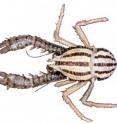Finding the ASX200 for marine ecosystems
Researchers are building the environmental equivalent of the ASX200 as a means of monitoring the health of Australian marine ecosystems. The state of an ecosystem can be understood by measuring the right ecological characteristics, just as the ASX200 index shows the state of the Australian stock market by following 200 selected stocks.
CSIRO Wealth from Oceans Flagship scientist Dr Keith Hayes, one of the leaders of the project, says the difficult part is selecting which characteristics to track.
"Ecosystems respond to multiple pressures and threats in complex ways," Dr Hayes says.
"Identifying reliable and robust indicators of change from among the many species and characteristics of the system is a challenging task."
In a pilot project undertaken for the Department of Environment, Water, Heritage & the Arts (DEWHA) last year, CSIRO identified indicators for five 'key ecological features' named by the Commonwealth Government for the South-West Marine Region off Western Australia's coast.
Key ecological features chosen for this study included the Perth Canyon and large ocean eddies.
The indicators were different for each feature, but they included things like numbers of sea birds, area of coral compared to algae, and phytoplankton size.
Such indicators will help provide a firm scientific basis to feed into State of the Environment reporting at regional, national and international scales.
"Indicators are an important topic in environmental circles right now as they help us make better decisions about managing the environment," Commonwealth Environment Research Facilities (CERF) Marine Biodiversity Hub director Professor Nic Bax says.
CSIRO's approach uses qualitative modelling, supported by asset and threat mapping, to understand the drivers and pressures on ecological features, and to predict how these features will respond to changes over the next five to 15 years.
"Having selected a suite of indicators, the next challenge is to measure them and test how they are predicted to change when subject to processes such as climate change, industrial development and fishing pressures," Dr Hayes says.
"We were really pleased with the results of the pilot project and have now embarked on a two-year program with DEWHA to develop a list of ecological indicators for the rest of Australia's marine territory."
This new project is in addition to the current CERF program.
The work will be presented at the Nationally Relevant Environmental Monitoring workshop in Canberra today and tomorrow, which is hosted by CSIRO and the Marine Biodiversity Hub.
Source: CSIRO Australia
Other sources
- Finding The ASX200 For Marine Ecosystemsfrom Science DailyTue, 20 Oct 2009, 19:21:39 UTC
- Finding the ASX200 for marine ecosystemsfrom PhysorgTue, 20 Oct 2009, 14:56:21 UTC
- New Insights Into Marine Ecosystems And Fisheries Productionfrom Science DailyMon, 19 Oct 2009, 6:14:32 UTC


